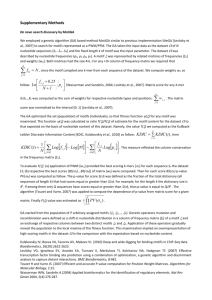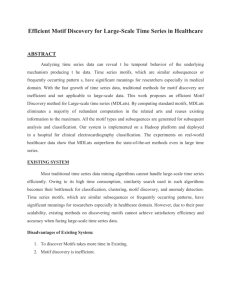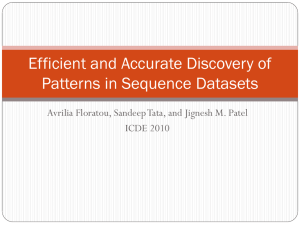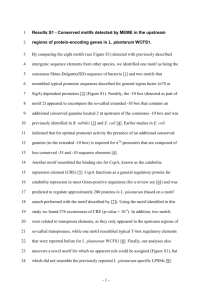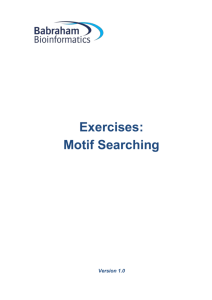mast
advertisement
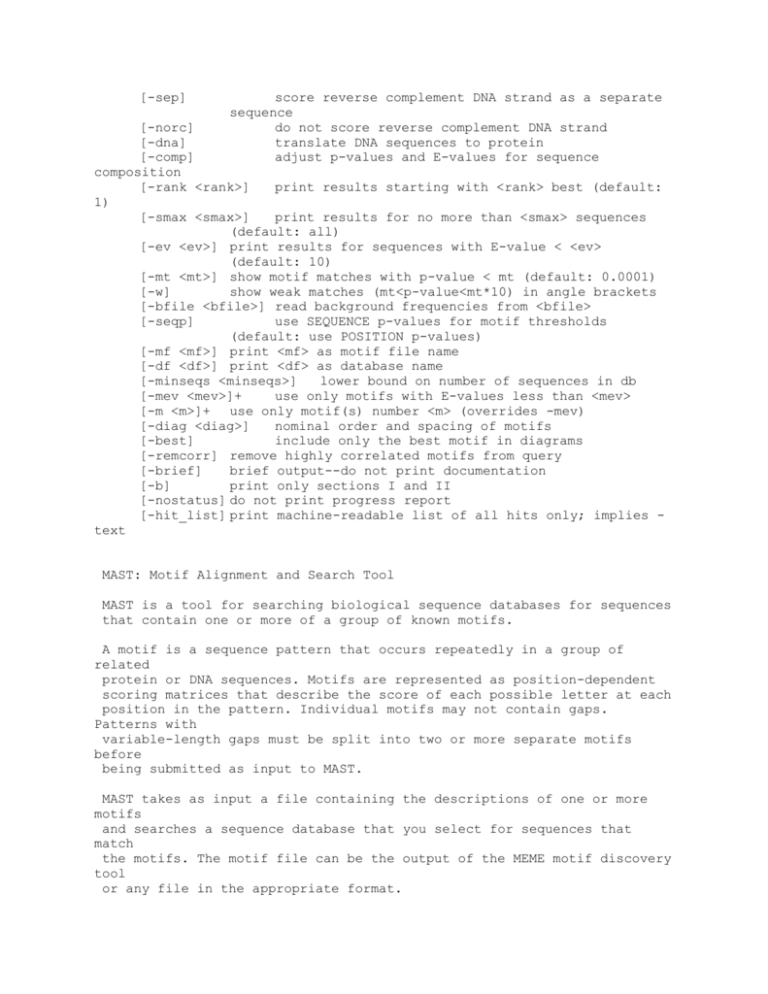
[-sep] score reverse complement DNA strand as a separate sequence do not score reverse complement DNA strand translate DNA sequences to protein adjust p-values and E-values for sequence [-norc] [-dna] [-comp] composition [-rank <rank>] print results starting with <rank> best (default: 1) [-smax <smax>] print results for no more than <smax> sequences (default: all) [-ev <ev>] print results for sequences with E-value < <ev> (default: 10) [-mt <mt>] show motif matches with p-value < mt (default: 0.0001) [-w] show weak matches (mt<p-value<mt*10) in angle brackets [-bfile <bfile>] read background frequencies from <bfile> [-seqp] use SEQUENCE p-values for motif thresholds (default: use POSITION p-values) [-mf <mf>] print <mf> as motif file name [-df <df>] print <df> as database name [-minseqs <minseqs>] lower bound on number of sequences in db [-mev <mev>]+ use only motifs with E-values less than <mev> [-m <m>]+ use only motif(s) number <m> (overrides -mev) [-diag <diag>] nominal order and spacing of motifs [-best] include only the best motif in diagrams [-remcorr] remove highly correlated motifs from query [-brief] brief output--do not print documentation [-b] print only sections I and II [-nostatus] do not print progress report [-hit_list] print machine-readable list of all hits only; implies text MAST: Motif Alignment and Search Tool MAST is a tool for searching biological sequence databases for sequences that contain one or more of a group of known motifs. A motif is a sequence pattern that occurs repeatedly in a group of related protein or DNA sequences. Motifs are represented as position-dependent scoring matrices that describe the score of each possible letter at each position in the pattern. Individual motifs may not contain gaps. Patterns with variable-length gaps must be split into two or more separate motifs before being submitted as input to MAST. MAST takes as input a file containing the descriptions of one or more motifs and searches a sequence database that you select for sequences that match the motifs. The motif file can be the output of the MEME motif discovery tool or any file in the appropriate format. MAST outputs three things: 1. The names of the high-scoring sequences sorted by the strength of the combined match of the sequence to all of the motifs in the group. 2. Motif diagrams showing the order and spacing of the motifs within each matching sequence. 3. Detailed annotation of each matching sequence showing the sequence and the locations and strengths of matches to the motifs. MAST works by calculating match scores for each sequence in the database compared with each of the motifs in the group of motifs you provide. For each sequence, the match scores are converted into various types of p-values and these are used to determine the overall match of the sequence to the group of motifs and the probable order and spacing of occurrences of the motifs in the sequence. MAST outputs a file containing: * * * * * the version of MAST and the date it was built, the reference to cite if you use MAST in your research, a description of the database and motifs used in the search, an explanation of the results, high-scoring sequences--sequences matching the group of motifs above a stated level of statistical significance, * motif diagrams showing the order and spacing of occurrences of the motifs in the high-scoring sequences and * annotated sequences showing the positions and p-values of all motif occurrences in each of the high-scoring sequences. Each section of the results file contains an explanation of how to interpret them. Match Scores The match score of a motif to a position in a sequence is the sum of the score from each column of the position-dependent scoring matrix corresponding to the letter at that position in the sequence. For example, if the sequence is TAATGTTGGTGCTGGTTTTTGTGGCATCGGGCGAGAATAGCGC ======== and the motif is represented by the position-dependent scoring matrix (where each row of the matrix corresponds to a position in the motif) =========|================================= POSITION | A C G T =========|================================= 1 | 1.447 0.188 -4.025 -4.095 2 | 0.739 1.339 -3.945 -2.325 3 | 1.764 -3.562 -4.197 -3.895 4 | 1.574 -3.784 -1.594 -1.994 5 | 1.602 -3.935 -4.054 -1.370 6 | 0.797 -3.647 -0.814 0.215 7 |-1.280 1.873 -0.607 -1.933 8 |-3.076 1.035 1.414 -3.913 =========|================================= then the match score of the fourth position in the sequence (underlined) would be found by summing the score for T in position 1, G in position 2 and so on until G in position 8. So the match score would be score = -4.095 + -3.945 + -3.895 + -1.994 + -4.054 + -0.814 + -1.933 + 1.414 = -19.316 The match scores for other positions in the sequence are calculated in the same way. Match scores are only calculated if the match completely fits within the sequence. Match scores are not calculated if the motif would overhang either end of the sequence. P-values MAST reports all matches of a sequence to a motif or group of motifs in terms of the p-value of the match. MAST considers the p-values of four types of events: position p-value: the match of a single position within a sequence to a given motif, sequence p-value: the best match of any position within a sequence to a given motif, combined p-value: the combined best matches of a sequence to a group of motifs, and E-value: observing a combined p-value at least as small in a random database of the same size. All p-values are based on a random sequence model that assumes each position in a random sequence is generated according to the average letter frequencies of all sequences in the the appropriate (peptide or nucleotide) non-redundant database (ftp://ncbi.nlm.nih.gov/blast/db/) on September 22, 1996. This can be overridden in two ways: 1) -bfile <bfile> The random model uses the letter frequencies given in <bfile> instead of the non-redundant database frequencies. The format of <bfile> is the same as that for the MEME -bfile opton; see the MEME documentation for details. Sample files are given in directory tests: tests/nt.freq and tests/na.freq.) 2) -comp The random model uses the letter frequencies in the current target sequence instead of the non-redundant database frequencies. This causes p-values and E-values to be compensated individually for the actual composition of each sequence in the database. This option can increase search time substantially due to the need to compute a different score distribution for each high-scoring sequence. Position p-value The p-value of a match of a given position within a sequence to a motif is defined as the probability of a randomly selected position in a randomly generated sequence having a match score at least as large as that of the given position. Sequence p-value The p-value of a match of a sequence to a motif is defined as the probability of a randomly generated sequence of the same length having a match score at least as large as the largest match score of any position in the sequence. Combined p-value The p-value of a match of a sequence to a group of motifs is defined as the probability of a randomly generated sequence of the same length having sequence p-values whose product is at least as small as the product of the sequence p-values of the matches of the motifs to the given sequence. E-value The E-value of the match of a sequence in a database to a a group of motifs is defined as the expected number of sequences in a random database of the same size that would match the motifs as well as the sequence does and is equal to the combined p-value of the sequence times the number of sequences in the database. High-scoring Sequences MAST lists the names and part of the descriptive text of all sequences whose E-value is less than E. Sequences shorter than one or more of the motifs are skipped. The sequences are sorted by increasing E-value. The value of E is set to 10 for the WEB server but is user-selectable in the down-loadable version of MAST. Motif Diagrams Motif diagrams show the order and spacing of non-overlapping matches to the motifs in each high-scoring sequence. Motif occurrences are determined based on the position p-value of matches to the motif. Strong matches (p-value < M) are shown in square brackets (`[ ]'), weak matches (M < p-value < M × 10) are shown in angle brackets (`< >') and the length of non-motif sequence ("spacer") is shown between dashes (`-'). For example, 27-[3]-44-<4>-99-[1]-7 shows an initial spacer of length 27, followed by a strong match to motif 3, a spacer of length 44, a weak match to motif 4, a spacer of length 99, a strong match to motif 1 and a final non-motif sequence of length 7. The value of M is 0.0001 for the WEB server but is user-selectable in the down-loadable version of MAST. Annotated Sequences MAST annotates each high-scoring sequence by printing the sequence along with the position and strength of all the non-overlapping motif occurrences. The four lines above each motif occurrence contain, respectively, the motif number of the occurrence, the position p-value of the occurence, the best possible match to the motif, and a plus sign (`+') above each letter in the occurrence that has a positive match score to the motif. The best possible match to a motif is the sequence of letters which would acheive the highest match score. Hit List If you specify the -hit_list switch to MAST, MAST outputs ONLY a list of "hits" in easily machine-readable format. Each line corresponds to one motif occurrence in one sequence. The format of the hit lines is [<sequence_name> <strand><motif> <start> <end> <p-value>]+ where <sequence_name> is the name of the sequence containing the hit <strand> is the strand (+ or - for DNA, blank for protein), <motif> is the motif number, <start> is the starting position of the hit, <end> is the ending position of the hit, and <p-value> is the position p-value of the hit. Two comment lines (starting with "#") is written above the list of hits, and the MAST command line is printed as a comment line after the list. An example of the output using the -hit_list switch to MAST is: # All non-overlapping hits in all sequences with E-values <= 10. # sequence_name motif hit_start hit_end hit_p-value ara +2 2 16 6.55e-08 ompa +2 5 19 2.74e-07 ce1cg -2 8 22 2.12e-06 bglr1 +2 1 15 1.48e-05 cya -2 19 33 6.91e-05 ilv -2 6 20 7.61e-05 malk +2 37 51 8.37e-05 gale +2 5 19 8.37e-05 # mast tests/meme.crp0.oops tests/crp0.s -stdout -hit_list -m 2 MOTIF FORMAT MAST can search using (multiple) motifs contained in a MEME output file, a GCG profile file, two or more GCG profile filess concatenated together, or a file with the following format. Motif file format ALPHABET= alphabet log-odds matrix: alength= alength w= w row_1 row_2 ... row_w A motif is represented by a position-dependent scoring matrix. A scoring matrix is preceded by a line starting with the words log-odds matrix: and specifying alength, the length of the alphabet (number of columns in the scoring matrix), and the w, the width of the motif (number of rows in the scoring matrix). The following w lines (no blank lines allowed) contain the rows of the scoring matrix. Row i, column j of the matrix gives the score for the j-th letter in alphabet appearing at position i in an occurrence of the motif. The spaces after the equals signs and the colon are required. The number of letters in alphabet must equal alength. Any number of additional motifs may follow the first one. The motif file must contain a line starting with ALPHABET= followed by alphabet, a list containing the letters used in the motifs. The order of the letters in alphabet must be the same as the order of the columns of scores in the motifs. The order need not be alphabetical and case does not matter, but there should be no spaces in alphabet. The letters in alphabet must be a subset of either the IUB/IUPAC DNA (ABCDGHKMNRSTUVWY) or protein (ABCDEFGHIKLMNPQRSTUVWXYZ) alphabets. DNA alphabets must contain at least the letters ACGT. Protein alphabets must contain at least the letters ACDEFGHIKLMNPQRSTVWY. All other letters in the alphabets are optional. If any of the optional letters are missing from alphabet, MAST automatically generates scores for them by taking the weighted average of the scores for the letters which the missing letter could match. (The weights are the frequencies of the replaced letters in the appropriate non-redundant database.) Replacements for the optional letters are given in the following table. LETTERS MATCHED BY OPTIONAL LETTERS ================================================= optional matches letter DNA protein ================================================= B CGT DN D AGT H ACT K GT M AC N ACGT R AG S CG U T ACDEFGHIKLMNPQRSTVWY V CAG W AT X ACDEFGHIKLMNPQRSTVWY Y CT Z EQ * ACGT ACDEFGHIKLMNPQRSTVWY ACGT ACDEFGHIKLMNPQRSTVWY ================================================= EXAMPLE Here is an example of a DNA motif file that contains two motifs. Sample motif file ALPHABET= ACGT log-odds matrix: -4.275 -0.182 -4.296 -1.487 -2.160 -1.492 -0.810 -4.076 1.537 -1.487 0.113 0.340 -0.454 0.923 -1.336 -0.082 0.674 -4.183 log-odds matrix: -2.032 0.324 -0.409 0.560 -4.274 -0.519 -2.188 2.300 1.265 -4.111 -1.977 2.158 alength= 4 w= 9 -4.195 1.408 1.880 -0.816 -4.171 1.474 1.872 -2.164 -4.195 -4.205 -0.237 -0.209 0.390 -0.834 0.905 0.100 0.130 -0.201 alength= 4 w= 6 1.371 -0.781 -0.250 0.119 -0.260 1.167 -4.191 -2.465 -0.267 -2.180 -1.661 -2.071 In the example above, because the order of the letters in alphabet is ACGT, the first column of each motif gives the scores for the letter A at each position in the motif, the second column gives the scores for C and so forth. Note: If -d <database> is not given, MAST looks for database specified inside of <mfile> Creates file (unless [-stdout] given) after stripping ".html" from the end of <mfile>: mast.<mfile>[.<database>][.c<count>][.m<motif>]+[.rank<rank>][.ev<e v>][.mt<mt>][.b] EXAMPLES: The following examples assume that file "meme.results" is the output of a MEME run containing at least 3 motifs and file SwissProt is a copy of the Swiss-Prot database on your local disk. DNA_DB is a copy of a DNA database on your local disk. 1) Annotate the training set: mast meme.results 2) Find sequences matching the motif and annotate them in the SwissProt database: mast meme.results -d SwissProt 3) Show sequences with weaker combined matches to motifs. mast meme.results -d SwissProt -ev 200 4) Indicate weaker matches to single motifs in the annotation so that sequences with weak matches to the motifs (but perhaps with the "correct" order and spacing) can be seen: mast meme.results -d SwissProt -w 5) Include a nominal order and spacing of the first three motifs in the calculation of the sequence p-values to increase the sensitivity of the search for matching sequences: mast meme.results -d SwissProt -diag "9-[2]-61-[1]-62-[3]-91" 6) Use only the first and third motifs in the search: mast meme.results -d SwissProt -m 1 -m 3 7) Use only the first two motifs in the search: mast meme.results -d SwissProt -c 2 8) Search DNA sequences using protein motifs, adjusting p-values and Evalues for each sequence by that sequence's composition: mast meme.results -d DNA_DB -dna -comp
